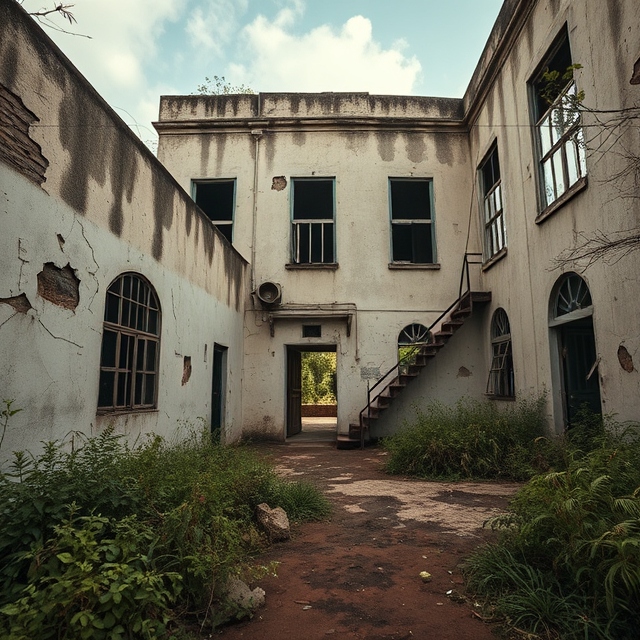Tales of the Abandoned Old Kuta Hospital

Exterior of the abandoned Old Kuta Hospital with broken windows and overgrown weeds.
The Abandoned Clinic: Tales from the Old Kuta Hospital
The hallway was cold. Even under the harsh glow of the fluorescent lights, the air felt sharp and unwelcoming. The sound of footsteps echoed faintly off cracked walls as though the building itself was alive, listening. The Old Kuta Hospital stood as a relic, abandoned for over two decades, but its stories felt alive as though they never left.
The Kuta Hospital was built in the early 1960s to serve as a regional health hub for the people in Kuta and nearby communities. For years, it functioned as the center for maternal care, surgeries, and general medical treatments. Staff members and patients alike would remember its welcoming reception area and bright, spacious wards, equipped with state-of-the-art equipment for its time.
But like many public institutions in Nigeria, the Kuta Hospital suffered under the strain of time, lack of funding, and systemic neglect. Overcrowding and administrative mismanagement weakened its service capabilities, and by the late 1980s, cracks started showing. Patients complained about shortages of supplies, and healthcare workers grew disillusioned. Services were scaled down, and by 2002, the hospital had completely shut its doors.
No one could have anticipated that years later, this abandoned clinic would become something much darker—an object of speculation and fear.
The first accounts of eerie activity in the Old Kuta Hospital began to surface a few months after its closure. Locals whispered of strange figures moving through the broken windows at night and unexplained noises that came from its halls—the kind of sounds that could chill the bones: footsteps, screams, and faint tapping noises.
The hospital had become an unofficial symbol of neglect, left behind by government budgets and citizens’ concerns. With no maintenance or guards assigned to its premises, it became easy for people with curiosity or mischief to wander its dark hallways. Some stories came from nearby residents, who claimed they saw shadows through the windows. These whispers started to build a pattern of an institution now feared more than it was loved.
But it wasn’t just talk. Those who ventured into the abandoned building had accounts that chilled even skeptics.
One story was from the night patrols that local security teams undertook. A security guard named Tayo, who had taken shifts monitoring public areas at night, recalled his encounter vividly. He had gone in to check on a suspected break-in when he swore he felt a hand brush against his shoulder. He froze. His heart beat in his chest. When he spun around, no one was there. His breath came fast as he peered into the shadows. All he could see was peeling paint and broken windows.
He left that night and never returned.
It was during the weekends that these stories grew in frequency. One local resident recounted an experience with his family. His mother had fallen ill, and they had gone to search for emergency supplies inside the old clinic. When they made their way to the storage area, they found cabinets overturned, drawers hanging loosely from broken hinges, and boxes scattered across the ground. But it wasn’t the sight of disrepair that unsettled them. A sudden sound—almost like a whisper—came from one of the small examination rooms. They froze, unsure of its source. When they tried to investigate, they found nothing.
The locals debated about what could have caused these noises. Some claimed it was merely old pipes or wind playing tricks on the sound waves. Yet, the strange movements—figures disappearing through doorways, the sound of hurried footsteps when there were no footsteps at all—convinced others of something far worse.
Many blamed the lingering spirits of patients. The hospital had witnessed countless deaths over the years, particularly during childbirth and emergencies. Maternal mortality rates were high, and the overcrowded conditions left patients vulnerable. Some believed that the unburied souls of the departed remained within those walls, caught between this world and the next.
By 2006, the stories had grown too large to ignore. Even local government officials would hesitate to visit the Old Kuta Hospital. People began speaking about the clinic as a place where bad things happened—a cursed structure or a haunting. Word of this spread through Kuta and nearby villages until the hospital became a sort of urban legend, its name spoken in hushed tones and with an edge of dread.
Still, no one did much to investigate. The government had bigger issues to deal with, and no resources were allocated to restoring the clinic or determining whether these stories held any truth. The buildings decayed, the walls cracked further, and the air grew colder each passing year.
But curiosity has a way of pushing people into danger. In 2010, a group of urban explorers decided to investigate the old clinic. They had heard the stories and wanted answers for themselves. With cameras in hand, they made their way through the broken front gates and toward the rotting structure. What they found defied even their wildest expectations.
Inside the clinic, the smell of mildew and rust mixed with the faint remains of antiseptic, a reminder of the place’s original purpose. The group documented everything as they ventured deeper into the structure. Examination rooms, waiting areas, and patient wards—all of them decrepit and unsafe—unfolded in front of them. Broken wheelchairs and rusted surgical instruments lay scattered in forgotten corners.
But as they moved through the main hallway, they heard it: the sound of footsteps. They paused, cameras ready, but no one was there. The air felt heavy, as though the sound had come from all directions. One of them pointed toward the old operating theatre.
It was locked. The door rattled faintly as though something was pushing it from the other side.
The explorers hesitated. One of them tried the handle and found it was jammed. Then, with a loud crash, something—or someone—moved inside. Panic swept through the group, and they fled without looking back. Their footage showed nothing but static after they ran, and when they returned to their homes, they couldn’t shake the feeling that they were being watched.
Stories like these only fueled fear among the locals. Some of the townspeople swore by accounts of patients’ cries heard at night, though nobody could confirm their origins. Was this simply a psychological response to years of neglect and superstition? Or was the clinic genuinely haunted by the memories of its many losses?
Attempts to officially investigate the hospital in later years only heightened the mystery. When investigators attempted to gather evidence, they discovered strange patterns of disrepair that suggested the structure wasn’t just falling apart from neglect. Some materials, particularly in old records and archives, were missing or vandalized. Was this evidence of exploration by others? Or was it deliberate destruction?
These questions remain unanswered.
Today, the Old Kuta Hospital stands as a skeletal monument to time, its halls locked, its windows shattered, and its walls worn. It no longer serves the purpose it once did, and most locals pass it with a shudder, avoiding its presence. To this day, residents of Kuta can’t help but wonder what really happens behind those walls at night.
No official report, no medical statistic, and no explanation can ever wipe the sensation of cold air, footsteps, and whispers—a reminder that some places are meant to stay abandoned, even if they can never truly remain forgotten.







